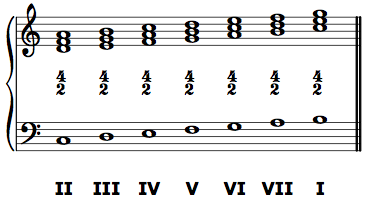Inquiry-Based Music Theory OER Text Book
Lesson 3a - Triads
Class Discussion
After agreeing on the terminology discussed in the Overview 3a, our first goal was to come up with a way to define each triad quality. The first suggestion for classifying triads attempted to break the triad qualities into two groups based on the defining chord members of the triads.
- The chordal third determines whether a triad is major or minor.
- The chordal fifth determines whether the triad is diminished or augmented.
This is an excellent way to summarize the most active chordal members, but it assumes a prior knowledge of triadic construction. After pointing this out, the student added three additional (and vital) pieces of information:
- Major and minor triads always have a perfect 5th between the root and chordal fifth.
- Diminished triads always have a minor 3rd between the root and chordal third.
- Augmented triads always have a major 3rd between the root and chordal third.
From this, we can create a couple of simple groupings based on the chord members:
- Between root and chordal 3rd
- Augmented and major triads always have a M3 (or inversion)
- Minor and diminished triads always have a m3 (or inversion)
- Between root and chordal fifth
- Major and minor triads always have P5 (or inversion)
- Diminished triads always have a d5 (or inversion)
- Augmented triads always have an A5 (or inversion)
Therefore, if a triad is in root position, you can determine triad qualities by the measuring the intervals of the stacked thirds.
- Major: M3 + m3
- Minor: m3 + M3
- Diminished: m3 + m3
- Augmented: M3 + M3
Inversions and their labels
Having identified the intervallic structures of each triad, we moved to the example of various inversions of the same triad. This meant we needed to know the names of inversions, the shorthand method for labeling inversions, and how to determine a chord quality of a triad that is not presented in root position (stacked as two thirds on top of each other.) From the simple presentation of this example, they were able to identify that it is not necessary to know each interval within a triad to determine the inversion, but instead, you only need to identify the chordal member in the bass.
- Root position: 5/3
- the root of the chord is in the bass
- The
5and3refer to the simple intervals above the bass
- First inversion: 6/3 (shortened to 6)
- the 3rd of the chord is in the bass
- The
6and3refer to the simple intervals above the bass
- Second inversion: 6/4
- the 5th of the chord is in the bass- The
6and4refer to the simple intervals above the bass
- the 5th of the chord is in the bass- The
Of note, there are six different possible intervals in a triad, depending on the inversion: two 3rds, two sixths, one fourth, and one fifth. These intervals always exist between the same two chord members.
- The thirds exist between the root-third and third-fifth
- The sixths come when you invert these either of the thirds, so between the third-root and fifth-third
- The fifth always exists between root-fifth
- The fourth is the inversion of the fifth, so between fifth-root
Chordal voicings
While this information is all correct, it assumes that you already know what the root of the triad. To develop a method for finding the root of an unnamed chord, we must first understand how the inversion interacts with the chord’s voicing.
We had many interesting suggestions in how to determine whether a chord is in an open or closed voicing based on the examples, and they became successively more succinct.
- open voicing is spread out
- True, but this is a fairly subjective measure. What consititutes “spread out”?
- closed positions use simple intervals and open positions use compound intervals
- This one was interesting in that it works if the chord only has four notes, but does not hold up if there are five or more chord members.
- open position skips one of the voices
- This definition is basically correct, but the term “voices” is problematic because voices does not relate directly to the chord.
The final definition combined these three ideas.
- Closed voicings are stacked in the closest possible groupings and skip no chord members.
- Open voicings can be stacked in any order and skip chord members.
Root versus bass
Understanding the difference between the terms root and bass is the last piece of information necessary to find the quality of any chord; students often confuse the two. The term bass always refers to the lowest voice of any chord. The root is the lowest member of the chord if the chord is in root position, meaning that the triad is stacked as two thirds. If a chord is in root position, the root and bass will be the same pitch, however if a triad is in first- or second- inversion, the root and bass will be different pitches.
Finding a chord quality while inverted
Combining a knowledge of inversins and voicings is critical in finding chord qualities. Teachers often suggest to students that they can find chord qualities by putting a chord in root position, but a chord in root position can be spread across multiple staves and still difficult to parse. We really mean that they should put the chord in root position and closed voicing. This allows the student to look at the interval qualities and determine the quality of the triad based on their knowledgeo of triadic interval structures.
If you can get it to root position closed voicing, you can figure out the chord. A triad is 3 distict pitches, with root position only using thirds.
Bass vs. Root
- the bass note can be moved around, and determines inversion
- the root is fixed, and decides how we name the chord
Circle of Thirds
- spelled: C E G B D F A
- a tool to help spell triads in tertian harmony no matter the letter name
- D, Db, D# are all spelled with a D, an F, and an A, with whatever appropriate accidental
Further Reading
From Open Music Theory
A chord is any combination of three or more pitch classes that sound simultaneously.
A three-note chord whose pitch classes can be arranged as thirds is called a triad.
To quickly determine whether a three-note chord is a triad, arrange the three notes on the “circle of thirds” below. The pitch classes of a triad will always sit next to each other.
Identifying and labeling triads
Triads are identified according to their root and quality.
Triad roots
To find a triad’s root, arrange the pitch classes on a circle of thirds (mentally or on paper). The root is the lowest in the three-pitch-class clump. Expressed another way, if the circle ascends by thirds as it moves clockwise, the root is the “earliest” note (thinking like a literal clock), and the other pitch classes come “later.”
Once you know the root, you can identify the remaining notes as the third of the chord (a third above the root) and the fifth of the chord (a fifth above the root).
Triad qualities
To find a triad’s quality, identify the interval between the root and the other members of the chord. There are four qualities of triads that appear in major and minor scales, each with their own characteristic intervals.
- major triad: M3 and P5 above the root (as in do–mi–sol)
- minor triad: m3 and P5 above the root (as in do–me–sol or la–do–mi)
- diminished triad: m3 and d5 above the root (as in ti–re–fa)
- augmented triad: M3 and A5 above the root (as in me–sol–ti)

Building a triad
To build a triad on the staff, identify the root, quality, and bass note from the lead-sheet symbol. The root and quality will tell you what three pitch classes belong to the triad. For example, C+ tells you the root is C, and the quality is augmented. Since the quality is augmented, there is a major third above the root (E) and an augmented fifth above the root (G-sharp). Since there is no bass note appended to the lead-sheet symbol, the bass note is the same as the root: C. Write a C on the staff (in any comfortable register), then write the other chord tones (E and G-sharp) above the C (see the Caug triad in the above figure).
For Cm/E♭, the root is C, and the quality is minor. Since the quality is minor, there is a minor third above the root (E-flat) and a perfect fifth above the root (G). The slash identifies E-flat as the bass note. Write the E-flat on the staff. Then write a C and a G above it to complete the chord (again, see above).
When all the members of the triad are as close to the bass note as they can be, the chord is in what is called close position (C, Cm/E♭, and Cdim/G♭ above). When there are spaces between chord tones, the chord is in open position (Caug above). (In certain musical situations, only one of those positions will be useful or desirable.)
Listening to triads
Each triad quality has its own distinct sound, and to an extent that sound is preserved even when the chord is inverted (when the pitch classes are arranged so that a pitch class other than the root is in the lowest voice). As you practice identifying and writing triads, be sure to play the triads, both to check your analysis/writing and to develop the ability to identify chord qualities quickly by ear.
Inversions
Both bass lines and root progressions are important for the study and mastery of tonal harmony. Most of our work will focus on the bass lines, and what follows will help you analyze the root progressions present in any figured bass line. In other words, this will help you perform a Roman numeral analysis of a figured bass line.
Note that on the charts below, generic capital Roman numerals are provided.
Chords of the fifth
In any chord of the fifth (“root position”: 5/3 or 7/5/3 chord), the bass note and the root of the chord are the same. The Roman numeral to be assigned to any chord of the fifth, then, is the scale degree of its bass note. If do is in the bass, the bass is scale-degree 1, and the Roman numeral is I. If re is in the bass, the Roman numeral is II. And so on.
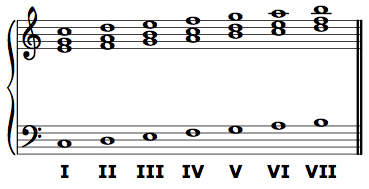
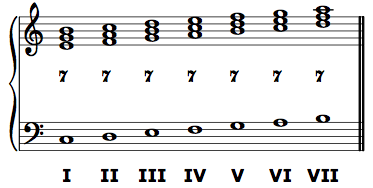
“First-inversion” chords of the sixth
Chords of the sixth that take the figures 6/3 or 6/5/3 are first-inversion chords. They are so named because the third of the chord (the next chord member above the root) is in the lowest voice. However, thinking about inversions while performing an analysis can be cumbersome. It is often simpler to remember that if the figure is 6/3 or 6/5/3 (or an abbreviation such as 6 or 6/5), the root of the chord is the sixth above the bass. If mi is in the bass, and the figure is “6”, the root is do, and the Roman numeral is I. If fa is in the bass and the figure is “6/5”, the root is re, and the Roman numeral is II. And so on.
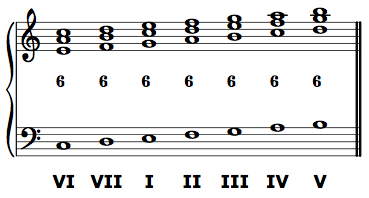
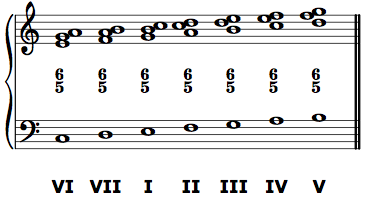
“Second-inversion” chords of the sixth
Chords of the sixth that take the figures 6/4 or 6/4/3 (or an abbreviation such as 4/3) are second-inversion chords. They are so named because the fifth of the chord (the second member of the chord above the root) is in the lowest voice. Again, it is often simpler to remember that for 6/4, 6/4/3, and 4/3 chords, the root is the fourth above the bass. If re is in the bass, and the figure is 4/3, the root is sol, and the Roman numeral is V.
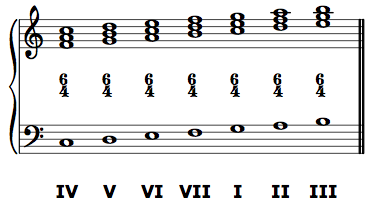
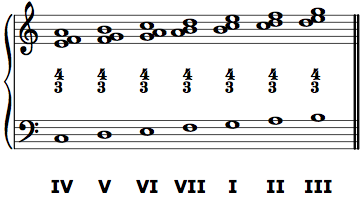
“Third-inversion” chords of the sixth
Chords of the sixth that take the figure 6/4/2 (or its abbreviation 4/2 or simply 2) are third-inversion chords. Their root is a second, or a step, above the bass. The most common 4/2 chord has fa in the bass, and sol is its root, making its Roman numeral V.
